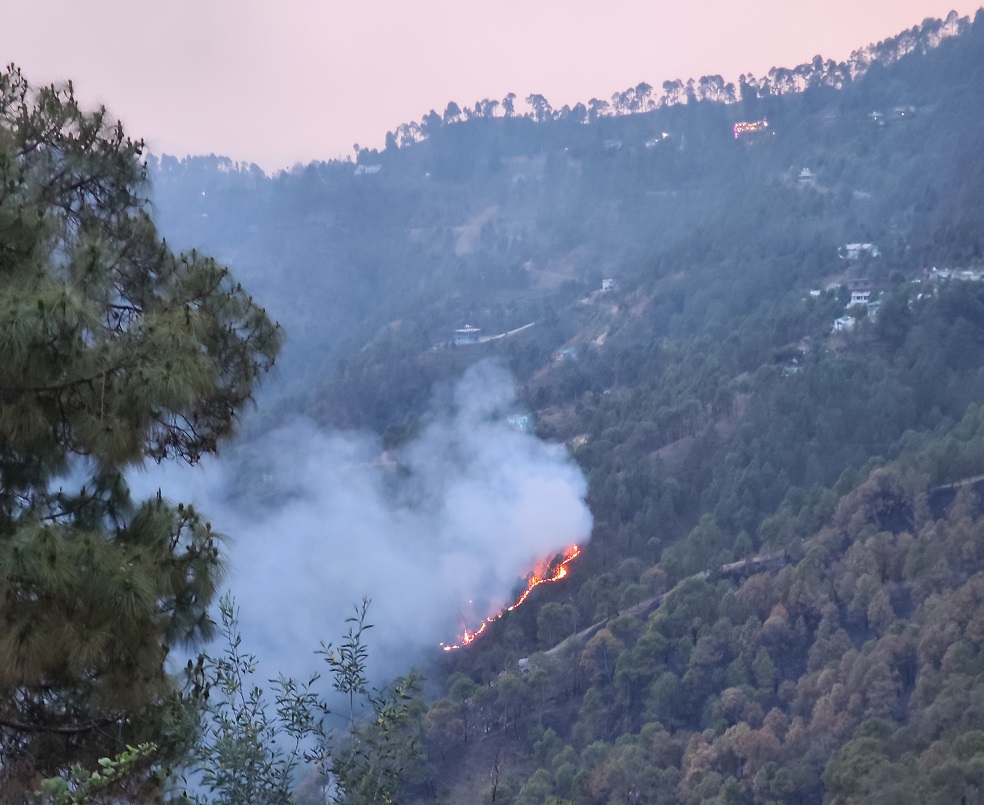
Uttarakhand’s Burning Breath: How Illegal Resin Tapping Fuels Devastating Forest Fires

The majestic Himalayas, the crown jewel of Uttarakhand, recently choked on smoke and flames. Over 1400 hectares of forest land were ravaged by wildfires, leaving behind a trail of ash and ecological devastation. While the rains have brought temporary relief, the real culprit behind these fires deserves a closer look: illegal resin extraction, specifically the destructive practice known as “blazing.”
Blazing a Trail of Destruction:
My recent travels across Uttarakhand in March and April 2024 revealed a heartbreaking truth. Everywhere I saw the scars of forest fires, and disturbingly, in every instance, the telltale marks of illegal resin extraction were etched on the pine trees. This brutal technique, “blazing,” is a major contributor to these wildfires.
Here’s how “blazing” ignites disaster:
- Bark Stripped Bare by Fire: Unlike sustainable methods that involve minimal bark removal, “blazing” involves ruthlessly using fire to cut deeper. Extractors intentionally burn sections of the bark on pine trees, leaving gaping wounds. This exposes the raw inner layers of the tree, making it highly vulnerable.
- Double the Danger: The use of fire in this process itself creates a double danger. Not only does burning weaken the tree, but even a small ember falling on the dry forest floor, littered with pine needles and debris, can easily spark a blaze. Even the direct exposure to hot summer sun can cause the fire to ignite or falling of the lightning can lead to quick fires.
- A Chain Reaction: These fires fueled by dry grass and flammable resin spread rapidly from tree to tree, especially with the “blazed” trees acting as tinderboxes. The extractor, focused solely on immediate gain, is unconcerned about extinguishing these fires, allowing them to spiral out of control.
The Fallout: A State Under Siege
The consequences of these “blazing”-induced wildfires are far-reaching:
- Ecological Devastation: The delicate balance of the Himalayan ecosystem is disrupted. The fires destroy habitats, displace wildlife, and threaten countless species of flora and fauna. Even protected areas like the Binsar Wildlife Sanctuary haven’t been spared.
- Natural Beauty Blighted: The very essence of Uttarakhand’s charm – the breathtaking vistas of the Himalayas – is obscured by smoke and ash. My own experience, spending 60 days in the state with only 2 days of clear Himalayan views, exemplifies this heartbreaking reality.
- Air Quality Plummeted: The smoke from these fires chokes the life out of the forests, making it difficult to breathe even in the heart of the greenery. This not only impacts wildlife but also poses a serious health risk to local communities.
A Call to Action: Breaking the Cycle and a Question for the Authorities
The ineffectiveness in curbing illegal “blazing” raises serious concerns. Is short-term profit truly worth the long-term devastation? We need immediate action:
- Stop the Blaze at its Source: Stricter enforcement measures are crucial. Increased patrolling, sting operations, and harsher penalties for “blazing” offenders can deter this illegal activity.
- Support Sustainable Practices: Promoting and incentivizing sustainable resin tapping methods that minimize bark removal and prioritize mature trees is key to breaking the cycle of destruction.
- Raise Awareness: Public awareness campaigns can educate communities about the devastating consequences of “blazing” and encourage responsible forest practices.
Uttarakhand’s future depends on the health of its forests. Let’s extinguish the flames of “blazing” and protect this irreplaceable natural treasure. By working together, we can ensure that the Himalayas continue to breathe and the state regains its breathtaking beauty. But the question remains: Will the authorities prioritize the well-being of Uttarakhand and its people over short-term benefits?
Hello, I am Aman (: Full Time Traveler :) At the age of 41, in April 2023, fueled by my love for travel and the determination not to remain fixed like a tree, I embarked on a bold journey. Having dedicated 17 years to a corporate job, I chose to transition from a full-time employee to a full-time traveler, driven by the desire to break free from the routine and constraints of a conventional life. Along the way, I not only explored the wonders of travel but also uncovered the transformative power of financial freedom. I realized how it could liberate me to lead a life teeming with adventure, purpose, and fulfillment. Through my blogs, I am passionately sharing my story, aiming to inspire and provide valuable guidance to those, like me, who aspire to weave travel into a life overflowing with limitless possibilities.






















Post Comment
You must be logged in to post a comment.